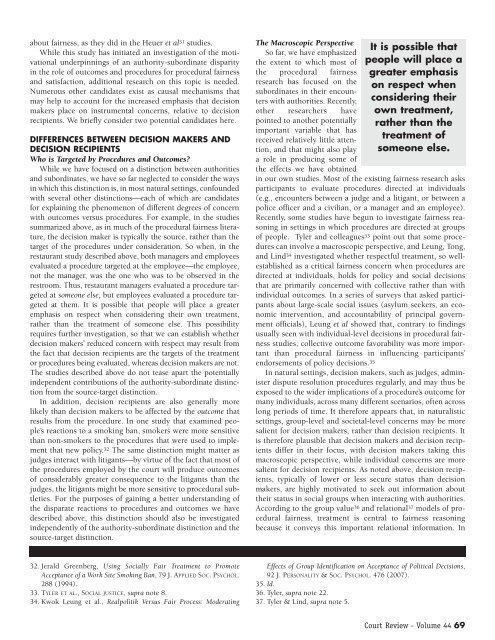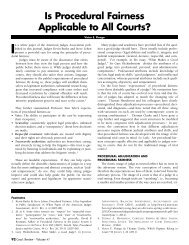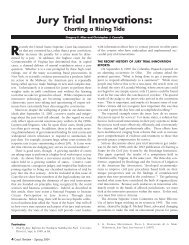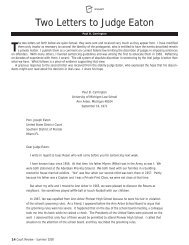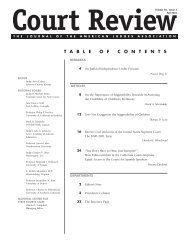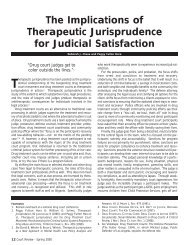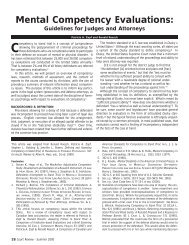Special Issue on Procedural Fairness - American Judges Association
Special Issue on Procedural Fairness - American Judges Association
Special Issue on Procedural Fairness - American Judges Association
- No tags were found...
You also want an ePaper? Increase the reach of your titles
YUMPU automatically turns print PDFs into web optimized ePapers that Google loves.
about fairness, as they did in the Heuer et al 31 studies.While this study has initiated an investigati<strong>on</strong> of the motivati<strong>on</strong>alunderpinnings of an authority-subordinate disparityin the role of outcomes and procedures for procedural fairnessand satisfacti<strong>on</strong>, additi<strong>on</strong>al research <strong>on</strong> this topic is needed.Numerous other candidates exist as causal mechanisms thatmay help to account for the increased emphasis that decisi<strong>on</strong>makers place <strong>on</strong> instrumental c<strong>on</strong>cerns, relative to decisi<strong>on</strong>recipients. We briefly c<strong>on</strong>sider two potential candidates here.DIFFERENCES BETWEEN DECISION MAKERS ANDDECISION RECIPIENTSWho is Targeted by Procedures and Outcomes?While we have focused <strong>on</strong> a distincti<strong>on</strong> between authoritiesand subordinates, we have so far neglected to c<strong>on</strong>sider the waysin which this distincti<strong>on</strong> is, in most natural settings, c<strong>on</strong>foundedwith several other distincti<strong>on</strong>s—each of which are candidatesfor explaining the phenomen<strong>on</strong> of different degrees of c<strong>on</strong>cernwith outcomes versus procedures. For example, in the studiessummarized above, as in much of the procedural fairness literature,the decisi<strong>on</strong> maker is typically the source, rather than thetarget of the procedures under c<strong>on</strong>siderati<strong>on</strong>. So when, in therestaurant study described above, both managers and employeesevaluated a procedure targeted at the employee—the employee,not the manager, was the <strong>on</strong>e who was to be observed in therestroom. Thus, restaurant managers evaluated a procedure targetedat some<strong>on</strong>e else, but employees evaluated a procedure targetedat them. It is possible that people will place a greateremphasis <strong>on</strong> respect when c<strong>on</strong>sidering their own treatment,rather than the treatment of some<strong>on</strong>e else. This possibilityrequires further investigati<strong>on</strong>, so that we can establish whetherdecisi<strong>on</strong> makers’ reduced c<strong>on</strong>cern with respect may result fromthe fact that decisi<strong>on</strong> recipients are the targets of the treatmentor procedures being evaluated, whereas decisi<strong>on</strong> makers are not.The studies described above do not tease apart the potentiallyindependent c<strong>on</strong>tributi<strong>on</strong>s of the authority-subordinate distincti<strong>on</strong>from the source-target distincti<strong>on</strong>.In additi<strong>on</strong>, decisi<strong>on</strong> recipients are also generally morelikely than decisi<strong>on</strong> makers to be affected by the outcome thatresults from the procedure. In <strong>on</strong>e study that examined people’sreacti<strong>on</strong>s to a smoking ban, smokers were more sensitivethan n<strong>on</strong>-smokers to the procedures that were used to implementthat new policy. 32 The same distincti<strong>on</strong> might matter asjudges interact with litigants—by virtue of the fact that most ofthe procedures employed by the court will produce outcomesof c<strong>on</strong>siderably greater c<strong>on</strong>sequence to the litigants than thejudges, the litigants might be more sensitive to procedural subtleties.For the purposes of gaining a better understanding ofthe disparate reacti<strong>on</strong>s to procedures and outcomes we havedescribed above, this distincti<strong>on</strong> should also be investigatedindependently of the authority-subordinate distincti<strong>on</strong> and thesource-target distincti<strong>on</strong>.The Macroscopic PerspectiveSo far, we have emphasizedthe extent to which most ofthe procedural fairnessresearch has focused <strong>on</strong> thesubordinates in their encounterswith authorities. Recently,other researchers havepointed to another potentiallyimportant variable that hasreceived relatively little attenti<strong>on</strong>,and that might also playa role in producing some ofthe effects we have obtainedIt is possible thatpeople will place agreater emphasis<strong>on</strong> respect whenc<strong>on</strong>sidering theirown treatment,rather than thetreatment ofsome<strong>on</strong>e else.in our own studies. Most of the existing fairness research asksparticipants to evaluate procedures directed at individuals(e.g., encounters between a judge and a litigant, or between apolice officer and a civilian, or a manager and an employee).Recently, some studies have begun to investigate fairness reas<strong>on</strong>ingin settings in which procedures are directed at groupsof people. Tyler and colleagues 33 point out that some procedurescan involve a macroscopic perspective, and Leung, T<strong>on</strong>g,and Lind 34 investigated whether respectful treatment, so wellestablishedas a critical fairness c<strong>on</strong>cern when procedures aredirected at individuals, holds for policy and social decisi<strong>on</strong>sthat are primarily c<strong>on</strong>cerned with collective rather than withindividual outcomes. In a series of surveys that asked participantsabout large-scale social issues (asylum seekers, an ec<strong>on</strong>omicinterventi<strong>on</strong>, and accountability of principal governmentofficials), Leung et al showed that, c<strong>on</strong>trary to findingsusually seen with individual-level decisi<strong>on</strong>s in procedural fairnessstudies, collective outcome favorability was more importantthan procedural fairness in influencing participants’endorsements of policy decisi<strong>on</strong>s. 35In natural settings, decisi<strong>on</strong> makers, such as judges, administerdispute resoluti<strong>on</strong> procedures regularly, and may thus beexposed to the wider implicati<strong>on</strong>s of a procedure’s outcome formany individuals, across many different scenarios, often acrossl<strong>on</strong>g periods of time. It therefore appears that, in naturalisticsettings, group-level and societal-level c<strong>on</strong>cerns may be moresalient for decisi<strong>on</strong> makers, rather than decisi<strong>on</strong> recipients. Itis therefore plausible that decisi<strong>on</strong> makers and decisi<strong>on</strong> recipientsdiffer in their focus, with decisi<strong>on</strong> makers taking thismacroscopic perspective, while individual c<strong>on</strong>cerns are moresalient for decisi<strong>on</strong> recipients. As noted above, decisi<strong>on</strong> recipients,typically of lower or less secure status than decisi<strong>on</strong>makers, are highly motivated to seek out informati<strong>on</strong> abouttheir status in social groups when interacting with authorities.According to the group value 36 and relati<strong>on</strong>al 37 models of proceduralfairness, treatment is central to fairness reas<strong>on</strong>ingbecause it c<strong>on</strong>veys this important relati<strong>on</strong>al informati<strong>on</strong>. In32. Jerald Greenberg, Using Socially Fair Treatment to PromoteAcceptance of a Work Site Smoking Ban, 79 J. APPLIED SOC. PSYCHOL.288 (1994).33. TYLER ET AL., SOCIAL JUSTICE, supra note 8.34. Kwok Leung et al., Realpolitik Versus Fair Process: ModeratingEffects of Group Identificati<strong>on</strong> <strong>on</strong> Acceptance of Political Decisi<strong>on</strong>s,92 J. PERSONALITY & SOC. PSYCHOL. 476 (2007).35. Id.36. Tyler, supra note 22.37. Tyler & Lind, supra note 5.Court Review - Volume 44 69


